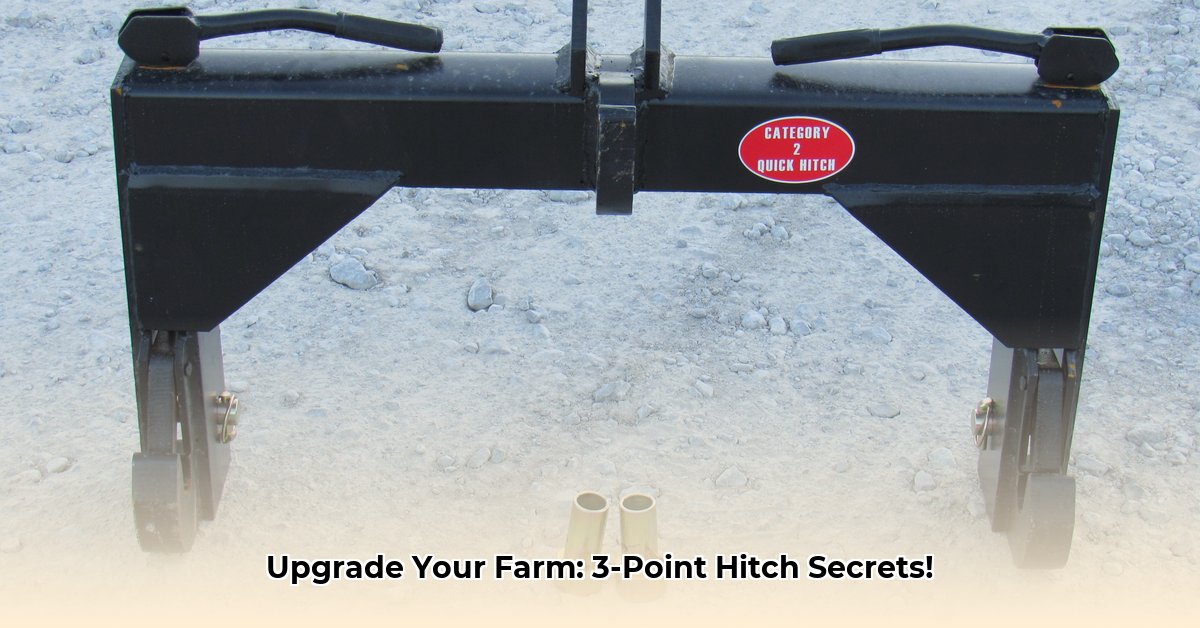
Choosing the right 3-point quick hitch attachments for your tractor is crucial for both efficiency and sustainable farming practices. This guide provides a step-by-step approach to selecting and using attachments that optimize your farm's productivity while minimizing environmental impact. For more information on 3-point hitches, check out this helpful resource: tractor supply.
Selecting the Right 3-Point Hitch Attachment
The ideal 3-point hitch attachment depends on your specific farming needs and the type of crops you cultivate. Before making a purchase, consider these key factors:
1. Compatibility and Fit
Ensure the attachment is fully compatible with your tractor's 3-point hitch system. Check the manufacturer's specifications carefully to avoid costly mistakes. A mismatch can lead to damage and inefficiency. Always double-check the specifications before purchasing any attachment.
2. Durability and Longevity
Invest in high-quality attachments built to withstand the demands of farm work. Durable attachments minimize the need for frequent repairs and replacements, ultimately saving you money in the long run. How much will a poorly made attachment cost you in lost work-time and repairs?
3. Versatility and Multi-Functionality
Consider attachments that can perform multiple tasks. Versatile tools often provide better value for your investment compared to single-purpose equipment. This is especially important for smaller farms with limited storage space.
4. Ease of Maintenance
Choose attachments with simple, straightforward maintenance requirements. Regular upkeep extends the lifespan of your tools and prevents unexpected downtime. Regular maintenance should be a routine part of your farming schedule.
Optimizing Your 3-Point Hitch System for Maximum Efficiency
Efficiently using your 3-point hitch attachments is just as important as selecting the right ones. Follow these steps to maximize your productivity:
1. Proper Setup and Adjustment
Before each use, ensure the attachment is correctly connected and adjusted. Improper setup can damage equipment and reduce efficiency. Always double-check your setup before starting any work.
2. Regular Inspection and Maintenance
Regularly inspect your attachments for signs of wear and tear. Addressing small problems promptly prevents them from escalating into major issues. Schedule regular maintenance checks to identify potential problems before they become costly.
3. Adapting to Conditions
Adjust your operating speed and settings to match the terrain and conditions. This protects your equipment and improves its overall performance. Remember that changing conditions require adjustments to your technique and the equipment's settings.
Sustainable Farming Practices with 3-Point Hitch Attachments
Sustainable agriculture is increasingly critical. Here's how to minimize environmental impact:
1. Soil Conservation
Utilize attachments designed to minimize soil compaction, such as no-till seed drills or low-disturbance cultivators. Compacted soil reduces water infiltration and impacts plant health. Protecting your soil is a cornerstone of sustainable farming.
2. Precision Agriculture
Embrace precision agriculture tools—GPS-guided implements, variable-rate technology—to optimize fertilizer and pesticide application, minimizing waste and environmental damage. Precision agriculture technologies are essential for sustainable farming.
3. Fuel Efficiency
Choose fuel-efficient attachments and operate them properly. Proper maintenance and efficient operation techniques significantly contribute to reducing your carbon footprint. Fuel efficiency is both economically and environmentally advantageous.
Choosing the Right Tools: A Sustainability Checklist
While comprehensive data on the environmental impact of specific attachments is still developing, consider these factors:
| Attachment Type | Potential Sustainability Benefits | Potential Sustainability Drawbacks | Data Availability |
|---|---|---|---|
| No-Till Seed Drills | Reduced soil erosion, improved soil health | Higher initial cost, potential for uneven seed placement | Limited but growing |
| Precision Fertilizer Spreaders | Minimized fertilizer waste, optimized nutrient use | Higher initial cost, reliance on accurate data | Limited but growing |
| Low-Disturbance Cultivators | Reduced soil compaction, effective weed control | May not be suitable for all soil types or weed levels | Limited but growing |
The Future of Sustainable 3-Point Hitch Attachments
The future of 3-point hitch attachments likely involves:
- Increased Automation and Precision: Expect more technologically advanced attachments with GPS, sensors, and automation features.
- Modular Designs: Modular designs will enhance versatility and reduce the need for multiple tools.
- Sustainable Materials: The use of durable, sustainable materials in attachment construction will become increasingly prevalent.
By carefully selecting and utilizing your 3-point quick hitch attachments, you can improve your farm's efficiency and contribute to a more sustainable agricultural landscape. Remember that informed decision-making is vital for both your farm's success and the environment’s well-being.